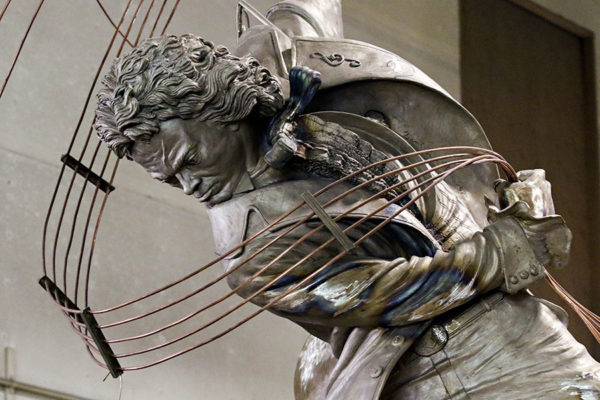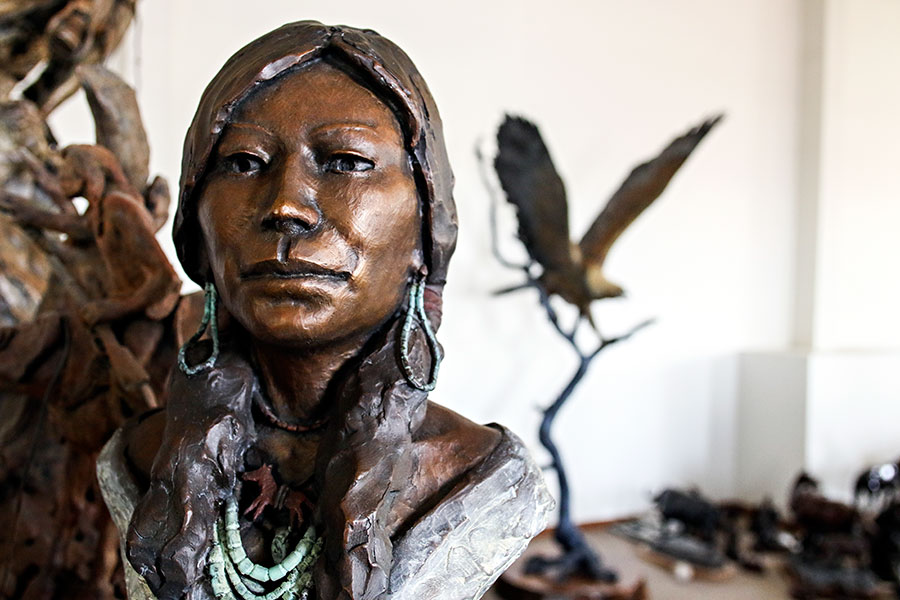EVERGREEN – There’s a small, bronze zoo in the gallery at Kalispell Art Casting, with sculptures of all sizes depicting a wide swath of the animal kingdom: horses, deer, dogs, manta rays, rhinos, giraffes, sheep, eagles, elk, goats, bison, pheasants, turkeys, foxes, water buffalo, and a very handsome bust of a Scottie dog.
The work is overwhelming as a whole, with so much different artistic expression standing in one room.
That’s what it’s been like at Kalispell Art Casting, a bronze foundry, for the last 40 years. It’s a tradition Jeremy Fairchild, a manager at the foundry, said has taken on extra importance as the world continues to evolve into digital perfection.
“Everything is going digital, with machines making perfect recreations or sculptures,” Fairchild said. “Real art allows for human error.”
The bronze-casting process is an art form in its own right, but the talented folks at Kalispell Art Casting work there to make other artist’s visions come to life. Anyone can bring in a model of what they would like to be a bronze sculpture, Fairchild said.
Customers from around the country and the world send their plans to the foundry, where the staff takes it through a many-stepped process of making a mold and being able to fill that mold with liquid, molten bronze. To get to that point, the model – which can be made of pretty much anything, Fairchild said — starts in the mold room.
There, it is photographed and cut up into pieces according to how it will be cast. Hot wax is poured into the mold, then removed once it cools. The wax copy is dipped into glue then three types of sands with increasing levels of coarseness. This shell hardens in a kiln, where the wax melts and flows out leaving the shell hollow.
The shell is reheated and placed upside down in sand, where the molten bronze is poured in. After the shell cools, it is hammered or sandblasted away to reveal the bronze sculpture. Kalispell Art Casting’s staff then works out the imperfections or seams and welds the sculpture together, all with input from the artists.
The final steps are to add patina — liquid chemicals torch-burned into the metal to add color — a marble base and a nameplate. The whole process takes six to 10 weeks.
One massive sculpture under construction shows an 11-foot-tall statue of the composer Beethoven surrounded by the notes of his first composition. It’s headed to a hotel in Florida.
“We’ve shipped bronze all over the world,” Fairchild said.

Started in 1979, Kalispell Art Casting was founded by owner Jack Muir, though Fairchild and fellow manager Mike Stephan are likely to take over once Muir retires from the business. The employees there are cross-trained to allow for a smoother transition in each step of the process, Fairchild said.
Bronze sculpting has become more expensive in recent years, he noted, with prices for bronze sitting at about $3.49 per pound. Bronze is an alloy of copper and tin, so the prices are dependent on those markets.
Looking back on 40 years with the digital future knocking, Fairchild said there is a shift from traditional sculptures of Montana scenes, people, and animals, to more modern sculpting in the younger generation. The key will be for the foundry to reach out to these new artists, Fairchild said.
“Montana will always have western and wildlife art,” he said. “But we are figuring out how to branch out in the new age of bronze.”
For more information on Kalispell Art Casting, visit www.kalispellartcastinginc.com.
